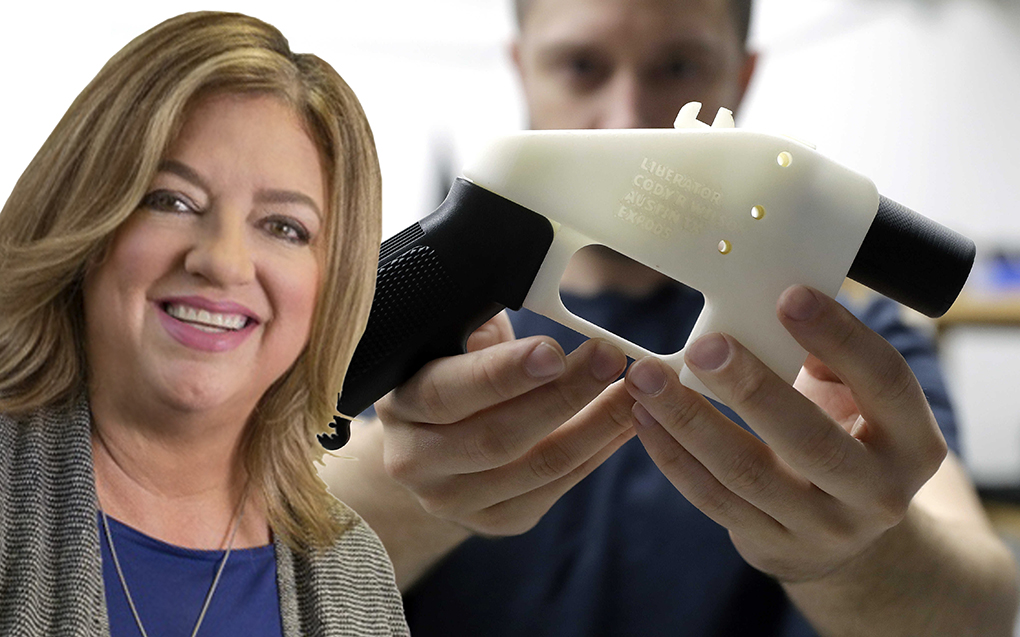Gunning For Free Speech or Rights to Bear Arms
Gunning For Free Speech or Rights to Bear Arms
 3D printing came center stage in the summer on 2018 in the United States with the release of 3-D printed gun blueprints on the Internet.
3D printing came center stage in the summer on 2018 in the United States with the release of 3-D printed gun blueprints on the Internet.
Every major news affiliate carried the story and raised warnings. The guns, printed in plastic, are touted as “ghost” guns because they are untraceable.

In late July, a U.S. judge blocked the planned release of 3-D printed gun blueprints hours before they were set to hit the Internet, siding with states that sued to halt publication of designs to make weapons that also are undetectable through security screening.
The issues arising from this new technology have rocked the legal community. First, gun control and gun-related issues have always been the purview of the Second Amendment to the U.S. Constitution, which sets forth a right to bear arms. However, the new blueprints for plastic guns, and their publication, are controlled by the First Amendment, which regulates a free press.
The issue is now about the right to pass on information to a global community. The Internet is unforgiving. Once that information is published, it’s out there. And the Texas-based company that designed these blueprints has already released them. That’s what has gun control advocates and all levels of government security officials up in, well, arms.
Eight states and the District of Columbia have filed a lawsuit against the federal government, arguing it acted arbitrarily in reaching an undisclosed settlement with the company in June. The states said online blueprints would allow criminals easy access to weapons. They said the Trump administration had failed to explain why it settled the case and that its decision violated their ability to regulate firearms and keep citizens safe.
Some of the files include 3-D printable blueprints for components that would go into the making of a version of the AR-15 semi-automatic assault rifle, a weapon that has been used in many U.S. mass shootings.
Ironically, the National Rifle Association (NRA), the sworn advocate of gun ownership, denounced the new weapons. “Regardless of what a person may be able to publish on the Internet, undetectable plastic guns have been illegal for 30 years,” Chris Cox, executive director of the NRA’s Institute for Legislative Action, said in a statement.
The irony is that the new plastic guns, while still far less efficient and far more expensive than manufactured ones, could eventually take market share away from the major gun OEMs, who are the lifeblood of the NRA. There are also laws against the guns in place. Under the U.S. Undetectable Firearms Act, any firearm that cannot be detected by a metal detector is illegal to manufacture, such designs for firearms require a metal plate to be inserted into the printed body.
While the printed guns got a lot of media attention, some analysts are shaking their heads. 3D printers capable of producing these guns have not saturated the market. Although more market penetration is anticipated, there are only roughly 6000 machines available that would work.
With more than 300 million non-military firearms on the streets in the U.S., their production would hardly make a dent. Therefore, it will take years for the printable gun industry to gain efficiency and mass productivity. By then, U.S. laws will have hopefully caught up.
Outside of the U.S., the guns are illegal in a variety of countries where gun regulations are in place, such as the United Kingdom and Australia. In Japan in 2014, Yoshitomo Imura was the first person to be arrested for possessing printed guns. After posting 3D gun plans on the Internet, Imura’s home was raided by authorities. He was found with five guns, only two of which were capable of being fired, but he had no ammunition.
 Tricia Judge has served as the executive director of the International Imaging Technology Council—a not-for-profit trade association serving imaging supplies remanufacturers and dealers—for 17 years. She was the executive editor of Recharger magazine for five years and a lawyer for 30 years. Judge’s work has been published in Recharger, Imaging Spectrum and several other industry magazines. She has won critical acclaim for her writing and industry advocacy. She prides herself in having assisted with the preparation of six friend-of-the-court (amicus) briefs and has presented the position of the industry to the US International Trade Commission. Since 2017, Judge has been the Senior Consulting Editor of RT Imaging World magazine and speaks at regional RT VIP Summits and RemaxWorld Expo in China.
Tricia Judge has served as the executive director of the International Imaging Technology Council—a not-for-profit trade association serving imaging supplies remanufacturers and dealers—for 17 years. She was the executive editor of Recharger magazine for five years and a lawyer for 30 years. Judge’s work has been published in Recharger, Imaging Spectrum and several other industry magazines. She has won critical acclaim for her writing and industry advocacy. She prides herself in having assisted with the preparation of six friend-of-the-court (amicus) briefs and has presented the position of the industry to the US International Trade Commission. Since 2017, Judge has been the Senior Consulting Editor of RT Imaging World magazine and speaks at regional RT VIP Summits and RemaxWorld Expo in China.
Her feature articles include:
- Intelligent Office Solutions: cartridges workflow and more
- Static Control Continues to Set High Industry Standards
- Brewer Reveals Impact on Imaging Supplies by COVID-19
- Aftermarket Scores Another Win – Canon loses: zero degrees is not an angle
- How Trade Associations Help Protect the Environment
- The U.S. Department of Energy Scores High with Remanufactured Cartridges
- Clover Imaging Ready to Take Remanufactured to the Next Level
- Uninet’s Mike Josiah Awarded Diamond Pioneering Award
Her Judge’s Ruling opinion blogs:
- Gunning For Free Speech or Rights to Bear Arms
- OEM Trademark Usage Leads to US Products Seizures
- New Builds Threaten to take Reman Share
- Election and Business Results Are In
- The Latest Dongle Gear Actions: Canon’s Checkmate
- Mobile Apps that Rule for This Judge
- 2017: There Will Never be Another One
- The Aftermarket Scores a Big Savory Win
- The Aftermarket Right That Shouldn’t Be An Afterthought
- Supreme Court Leans Towards Aftermarket
- Pivotal Patent Case has Support on Both Sides
- Council Presents its Issues to the US Supreme Court
- The Trump Presidency: Good or Bad for the Aftermarket
- US Supreme Court to Hear Lexmark Impression Products Case
- Election and Business Results Are In
- Canon’s Latest Dongle Gear Actions: Canon’s Checkmate
- Mobile Apps that Rule for This Judge
Comments:
You can add your ideas and thoughts on this article, “Gunning For Free Speech or Rights to Bear Arms,” below or directly with Tricia Judge by email











